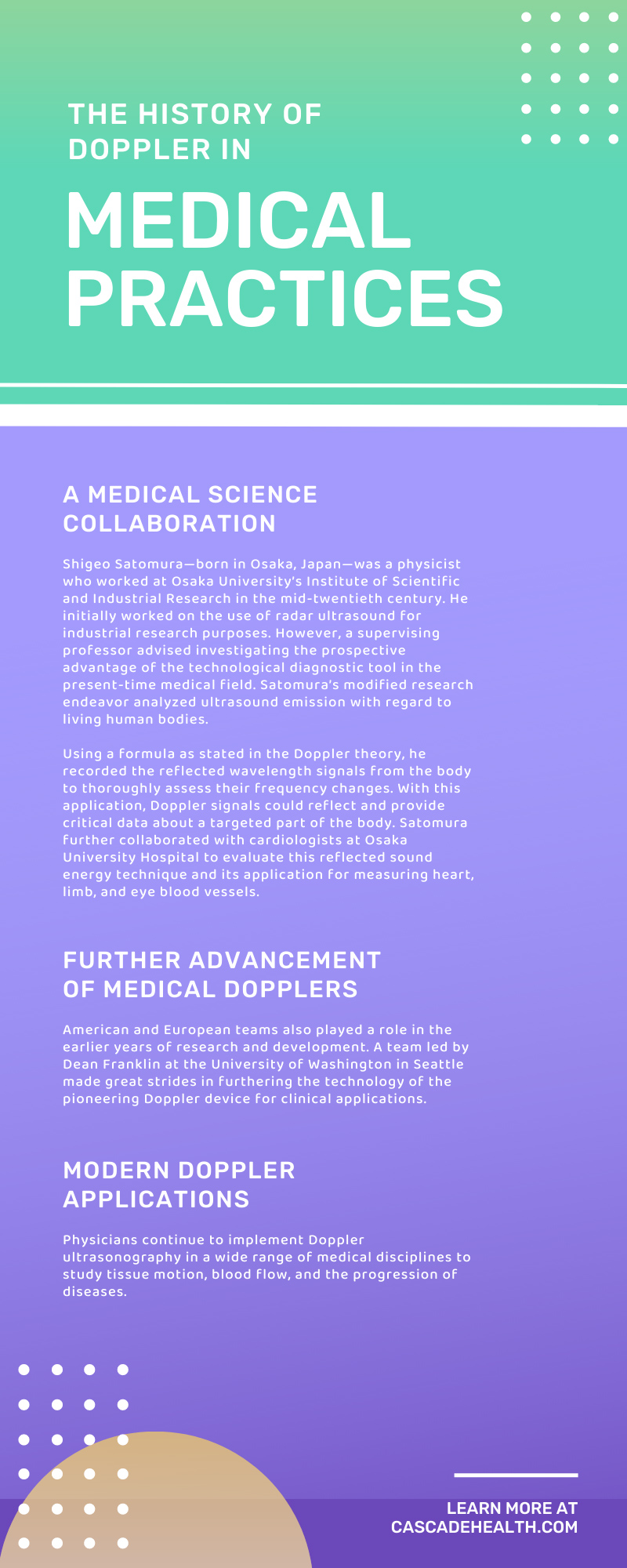The History of Doppler in Medical Practices
A culmination of technological advancement, expanded knowledge, and expert innovation continues to affect the medical field. In our modern era, one remarkable result of this combination is ultrasound instrumentation and application. Ultrasound holds significant influence in healthcare services as a non-invasive and readily accessible imaging technique. This influence is especially true of Doppler ultrasound technology.
As a more advanced form of traditional ultrasound, ultrasonographic imaging with Doppler allows healthcare providers ample opportunities for vascular system assessment. Through progressive research and development, Doppler ultrasound technology has come a long way to provide beneficial clinical applications. Implementation of the Doppler shift has revolutionized a wide array of fields—including astronomy and meteorology—but none as notable as the field of medicine.
Read on to discover the history of Doppler in medical practices, including a brief look at the development of medical ultrasonography with Doppler probes and the pioneers of this medical science process.
The Science Behind the Doppler Effect
The deep link between the medical and scientific fields is most notable in the Doppler effect’s relationship with diagnostic ultrasound technology. This natural phenomenon is a clear example of how a discovery in physics revolutionized health science for the better.
Now, what exactly is the Doppler effect? In terms of physics, the Doppler effect refers to a well-known perceived frequency shift of sound in relation to an observer. This change in observed wave frequency occurs due to the relative movement speed of the sound source and the observer.
Think of the frequency shift principle as similar to hearing the approaching horn of a train. As you listen, you can identify how the audible pitch changes from high to low as the train comes toward and moves away from you. The frequency is first compressed and then expanded, changing the pitch.
The Namesake of the Doppler Theory
The name “Doppler effect” is in honor of the Austrian physicist Christian Doppler, who initially unveiled the theory in 1842 to explain the colors of binary stars. The astronomical discovery demonstrated how the distance between sound or light waves changes as the source and observer move relative to one another. His discovery would go on to change history.
Christian Doppler received praise for his studies and theories, though he didn’t live to see the extensive influence of his findings. In time to come, researchers would begin to use this shift for a range of practical applications across various fields. Many accomplished discoveries would not have been possible without his work, but the Doppler effect’s greatest impact is in medicine. The original Doppler theory forms the basis of today’s fetal and vascular Doppler technology.
Doppler equipment generally works by listening to high-frequency sound waves, known as ultrasound. These devices use sensitive probes to transmit sound waves into the body and record the reflected echoes. The recorded signals from moving objects—such as a heartbeat or flowing blood—are then transformed into audible sounds, video pictures, graphs, or numerical readout displays on the Doppler device.
The Early Developments of Medical Dopplers
How did medical Doppler technology come to be? When considering the history of Doppler in medical practices, it’s essential to first look at the earliest developments of Doppler ultrasound scanning. The medical application of the Doppler effect mainly revolves around recording accurate measurements of blood flow and heart movements. The earliest developments of these ultrasonographic units occurred in Japan at Osaka University and the University of Washington in the United States.
A Medical Science Collaboration
Shigeo Satomura—born in Osaka, Japan—was a physicist who worked at Osaka University’s Institute of Scientific and Industrial Research in the mid-twentieth century. He initially worked on the use of radar ultrasound for industrial research purposes. However, a supervising professor advised investigating the prospective advantage of the technological diagnostic tool in the present-time medical field. Satomura’s modified research endeavor analyzed ultrasound emission with regard to living human bodies.
Using a formula as stated in the Doppler theory, he recorded the reflected wavelength signals from the body to thoroughly assess their frequency changes. With this application, Doppler signals could reflect and provide critical data about a targeted part of the body. Satomura further collaborated with cardiologists at Osaka University Hospital to evaluate this reflected sound energy technique and its application for measuring heart, limb, and eye blood vessels.
Satomura published a paper on the topic titled “A new method of the mechanical vibration measurement and its application.” In this presentation of his findings, he noted how Doppler signals could display heart movements when exposed to 3 MHz ultrasonic sound waves.
Recording these measurable movements provided valuable medical insight into an individual’s vascular system. Physicians could indicate situations of atrial/ventricular contraction and relaxation in patients. After his death, a team of Japanese physicists and physicians carried on Satomura’s dedication to developing these diagnostic tools for medical applications.
Further Advancement of Medical Dopplers
American and European teams also played a role in the earlier years of research and development. A team led by Dean Franklin at the University of Washington in Seattle made great strides in furthering the technology of the pioneering Doppler device for clinical applications.
However, a pivotal step for extending the Doppler technique’s use in medical practice came with the development of the ultrasonic duplex Doppler in the late 1970s. This echo-Doppler machine combined Doppler shift functions with 2D imaging in a single transducer probe.
Modern Doppler Applications
Physicians continue to implement Doppler ultrasonography in a wide range of medical disciplines to study tissue motion, blood flow, and the progression of diseases. Before the invention of this non-invasive medical device, monitoring circulation in the vascular system required an invasive process. These days, healthcare professionals safely observe and study blood flow and motion in the human body through Doppler, including reproduction and fetal perfusion.
Fetal Dopplers: Heart Rate Recording
Modern Doppler applications in medical practice involve the use of obstetric dopplers. These electronic monitoring tools are standard in OB settings, such as routine prenatal office visits and labor and delivery. Obstetricians and midwives start using Doppler technology during the 12th week of gestation to detect fetal heart movements. This application continues throughout pregnancy to listen to fetal heart tones non-invasively.
Vascular Dopplers: Velocity of Blood Flow
Present-day primary care doctors, cardiologists, and vascular specialists use vascular Dopplers to observe and monitor blood flow in veins, arteries, and various extremities. Medical Doppler equipment is essential for diagnostic ultrasound, including the ABI exam, which helps physicians diagnose the common condition of peripheral arterial disease.
Professional Doppler Technology and Equipment
After more than a century of theory, research, and development, Doppler technology has made significant, tangible medical advances. At Cascade Health Care, we carry an extensive selection of professional medical Dopplers for facility or provider use. Our assortment of medical Doppler equipment for obstetric and vascular applications features various options for probe frequency. Browse our curated collection of top-quality Doppler units from reputable manufacturers today.

Recent Posts
-
Exploring Recent Innovations in Doppler Signal Processing
Doppler technology has become an essential diagnostic tool in modern medicine, enabling healthcare p
-
Exploring Recent Innovations in Doppler Signal Processing
Doppler technology has become an essential diagnostic tool in modern medicine, enabling healthcare p


